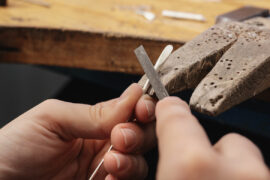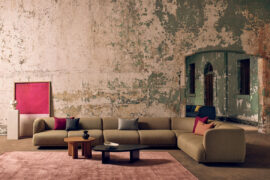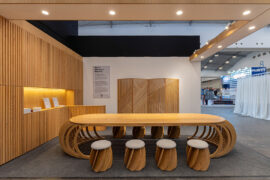The A+D world faces a precarious future: dwindling local expertise, unlikely local capacity, and a race we thought was heading toward the bottom but seems, instead, to be heading nowhere.
Although the current state of our property market might indicate our growing status as a well-designed nation, few of us in the A+D world are quite so sanguine. Tasked to close contracts faster and cheaper than ever before, our A+D community continues to report a culture of fear within the industry, circuitous monetary flows and wildly ambivalent consumer confidence – whether for key developments in our property market or for the position our industrial design will index on the world’s stage in the face of growing international competition.
At all avenues, we appear to be racing to the bottom faster than ever before. Needing to curb costs wherever possible in order to bolster our value proposition to the market, (namely, a value proposition that hangs solely on price point), the collateral damage has been enormous and, sadly it would seem, largely silent.
Within the space of a single workforce generation, our local manufacturing industry has experienced an ongoing period of contraction, falling to record lows on the Industries Group Index. In the 2015-2016 financial year, manufacturing’s injection into the national economy capped almost $30 billion AUD. Throughout the last financial year, however, it contributed less than $15,598 billion – a drop of almost 50% (which, comparatively, outstrips the drop experienced during the same parameters for our equally anxious mining industry).

It may sound flippant, but it feels all-too-familiar to me. Though few might be willing to see the correspondence, we find ourselves today in an oddly similar position to mid-Nineteenth-Century Europe. As the cause of industrialism continued to make in-roads into European social and political circles, the correlative emerged simultaneously for the continent’s economic thinking: the purportedly unspoken virtues of laissez-faire market drivers. We have novelists, in particular, to thank for the gainsaying. In the British tradition, Dickens, Eliot, Carlyle, Gaskell and any one of the Bronte family filled reams and reams of paper with the very human-centric tales of entire industries falling to task as the race to the bottom became more of a chaotic sprint.
But what might the Victorians teach us here? Well, for one thing, their response was inspired: intervention. Charter after charter was passed from the 1848 People’s Charter onwards, delineating strategies for mutually beneficial relationships between industry sectors: the cotton industry bolstered the weaving industry, textile trade and international trading relationships (even the colonial military) all working collaboratively to manage the ongoing struggles of ameliorating the rapid effects of mechanical innovation into an otherwise localised cottage IR structure. In short, the shift in industrial relations produced highly specialised skillsets as relationships became entirely driven by exclusivity and specialisation for quality control.
Needless to say, such effects are also currently extant within the A+D community. Relationships between our industrial designers and suppliers have never been richer and more penetrative. And yet, the local manufacturers still appear to be lucking out. While our lower dollar continues to boost manufacturing export volumes, weak local demand continues to subdue total activity as designers seek cheaper offshore alternatives.
According to a recent report by Fairfax, 83% of Australian voters believe that we have a responsibility to generate more revenue and jobs within our total manufacturing capacity. Such sentiments could not have arrived at a more pressing moment. Between 2008 and 2016, more than 300,000 manufacturing jobs were lost, now accounting for approximately 1 in every 13 workers.
“The public’s instinct is absolutely right,” says Jim Stanford, economist at the Centre for the Future of Work at the Australia Institute, following his key findings that this nation displays a significantly lower proportion of manufacturing capacity than any other comparably advanced economy. “We risk paying a long-term price if the decline continues.”
So, should the A+D world reconsider its relationship with manufacturers? After all, government deregulation of the commercial sector in particular – plus the constantly changing landscape of taxation and tariff control – doesn’t bode well for too heavy a reliance on offshore manufacturing in the long term (even if it does satisfy short-term commercial imperatives). While local expertise continues to decline, we are actively complicit in creating an arena that is not sustainable for our local industrial designers, their local and international suppliers and the push for seeing our local design language make a loud impact on the international level.
Under such conditions, never has ecologically and socially sustainable approaches to our industrial relationships been more pressing. And thankfully, some industrial designers are proving that understanding the future direction of our collective practice and the potentially errant market forces at play is key to our overall success – as a nation, as an industry, and as a design community.
Keith Melbourne is one such forward-thinker. Following the launch of his Pino collection for Zenith, Melbourne sat down with me to discuss his unique relationship with manufacturers, underscoring his discussion with the insight that closer collaborative approaches are key to the success of industrial design as a discipline, and design as both collective practice and community.
From designing all unique manufacturing componentry for the range, not to mention furniture kitted with ergonomic solutions for the manufacturers needing to construct these difficult product typologies – it becomes clear that it is near-impossible to delineate where Pino’s design story ends and its manufacture story begins. At all points, the difficulties, necessities and support systems for the range’s manufacture appear to inform its design resolution from the beginning. What emerges is not simply a product to decorate our mantle as a well-designed nation but, rather, the vital support system needed to ensure that the mantle will no longer be top-heavy.
David Congram, Indesign: You’ve commented elsewhere that Pino is unique for you because it was very much a balancing act between sustaining its characteristic wire form and still providing the level of comfort and performance we wouldn’t normally expect from hard furnishings.
Keith Melbourne: Yes, and ‘balancing act’ is the perfect term for it. [laughs] Well, sometimes, but it really was more of a pleasurable experience as a whole. And probably the number one thing which I found especially arduous this time with Pino was the manufacture. It was a wonderful challenge but I seriously underestimated the scope of the manufacturing side. We developed twelve manufacture components, and then spent two years refining the manufacturing process as a whole.
DC: Well, since the manufacture for Pino was largely uncharted territory for you in terms of the form of the range, was it key to collaborate with specialist manufacturers?
KM Oh absolutely! It was a very mutually-rewarding experience for both myself and the manufacturing team because it was such a prolonged collaborative process. Manufacturing is something that is very hidden, so I enjoy coming out and championing that part of the design process. Otherwise, how would people know?
DC And people are intensely interested in that part of the design process, too, I feel.
KM Yes, extremely so. It’s always met with a very high level of fascination. It has a tendency to ground the product, and really sweep away the unecessary ‘mystique’ that surrounds design as a discipline.
DC And when you were refining each element during that questioning, how many prototypes were required to truly test its functionality?
KM Interestingly, not many at all. I normally make a lot of models when I’m designing furniture, but it’s almost impossible to make a model of anything in the Pino range. When you take it down to one fifth of the scale, the wires don’t really translate. The accuracy required during the prototyping stage to inform the end-result just couldn’t be achieved for Pino because of its peculiar materiality. So largely it was done in CAD with some mock-ups in MDF for an ergonomic point of view.
DC That’s quite interesting because I imagine it would be rather uncommon –
KM Well yes – prototyping is an important part of any design process, but the material that constitutes the bulk of each piece wasn’t very welcoming of traditional prototyping, and certainly wasn’t particularly suited to dropping down the scale. I developed a new type of prototyping for this range using laser cut MDF to make a simulation of the chair, for example, so that you could sit inside to test the distribution of load and weight. Although it differs incredibly from the end result (not only in material) this way I was able to test and refine the ergonomics of each piece. But largely, I think we only did one prototype overall.
DC One?!
KM Yeah! But, thousands of megabytes of CAD data as well. It was an interesting challenge because I normally do like to make many models and work directly with the material and form. Unfortunately, or actually quite fortunately in a way, the material in this instance worked against the way I normally design.
DC You’ve told me quite a bit about the manufacturing side of developing this range, and I’m curious to know your opinion of the manufacturer-designer relationship.
KM Oh it’s extremely important! It’s critical as far as I’m concerned. I don’t work just by completing the design process and then passing the spec sheets through to the manufacturers. I prefer to work more collaborating alongside the manufacturers and I find very often that this also colours the design process to a great extent too, while also influencing the success of the design from a performance, quality or even aesthetic angle.
DC Do you think that is standard or rare for the design community currently working throughout Australia, in particular?
KM All designers I know have slightly different relationships with their manufacturers. Some, like me, are quite involved, and others can be very removed, some removed entirely as we often see with those who use offshore solutions. But I think that the line in the sand – where the manufacturer finishes and the designer starts – for me at least is very blurred. Perhaps that’s more informed by my engineering background than I know. But I love the relationship with the manufacturer. I spend a lot of time physically in the factory refining the manufacturing process. And the manufacturers love it too.
DC I imagine that the stronger the relationship between the manufacturer and the designer leads to a better-resolved product at the tail-end of the whole process.
KM Yes I’d have to agree. The whole process of the tooling side of things is about spending time refining those elements that can improve quality but also save time and a lot of funds too.
The design process for me can sometimes be quite lonely. I do a lot of the legwork alone and then the collaboration starts with the manufacturer where the sparks start to fly. I have a lot of respect with the manufacturers I work with, and the transference of skills and expertise is by far one of the most rewarding parts of this relationship.
Pino by Keith Melbourne is available exclusively through Zenith.
INDESIGN is on instagram
Follow @indesignlive
A searchable and comprehensive guide for specifying leading products and their suppliers
Keep up to date with the latest and greatest from our industry BFF's!

From the spark of an idea on the page to the launch of new pieces in a showroom is a journey every aspiring industrial and furnishing designer imagines making.

CDK Stone’s Natasha Stengos takes us through its Alexandria Selection Centre, where stone choice becomes a sensory experience – from curated spaces, crafted details and a colour-organised selection floor.

Merging two hotel identities in one landmark development, Hotel Indigo and Holiday Inn Little Collins capture the spirit of Melbourne through Buchan’s narrative-driven design – elevated by GROHE’s signature craftsmanship.

London-based design duo Raw Edges have joined forces with Established & Sons and Tongue & Groove to introduce Wall to Wall – a hand-stained, “living collection” that transforms parquet flooring into a canvas of colour, pattern, and possibility.

With the inaugural Glenn Murcutt Symposium set to take place in Sydney in September 2025, Pritzker Prize-winner Francis Kéré receives the Murcutt Pin.

Discover the range designed to let people gather and ideas flow

Winner of the INDE.Awards 2025 Best of the Best, Terminal 2 Kempegowda International Airport Interiors by Enter Projects Asia and SOM showcases 12,000-square-metres of biophilic design, featuring nine kilometres of handwoven rattan in a sustainable, world-class passenger experience.
The internet never sleeps! Here's the stuff you might have missed

Inside Bangkok’s Siam Paragon Mall, L’Atelier by Dinding Design Office celebrates the artistry of independent watchmaking through a space defined by light, craft and meticulous detail.

The Minns Labor Government has unveiled nine new architect-designed mid-rise apartment patterns, expanding the NSW Housing Pattern Book and accelerating the delivery of accessible, high-quality housing across the state.

The final instalment in our three-part series on collaborations between the world’s best designers and the American Hardwood Export Council.

BLP’s new Sydney Children’s Hospital, Randwick building brings together paediatric care, family-centred design and Australia’s first Children’s Comprehensive Cancer Centre in a major addition to the Randwick Health & Innovation Precinct.